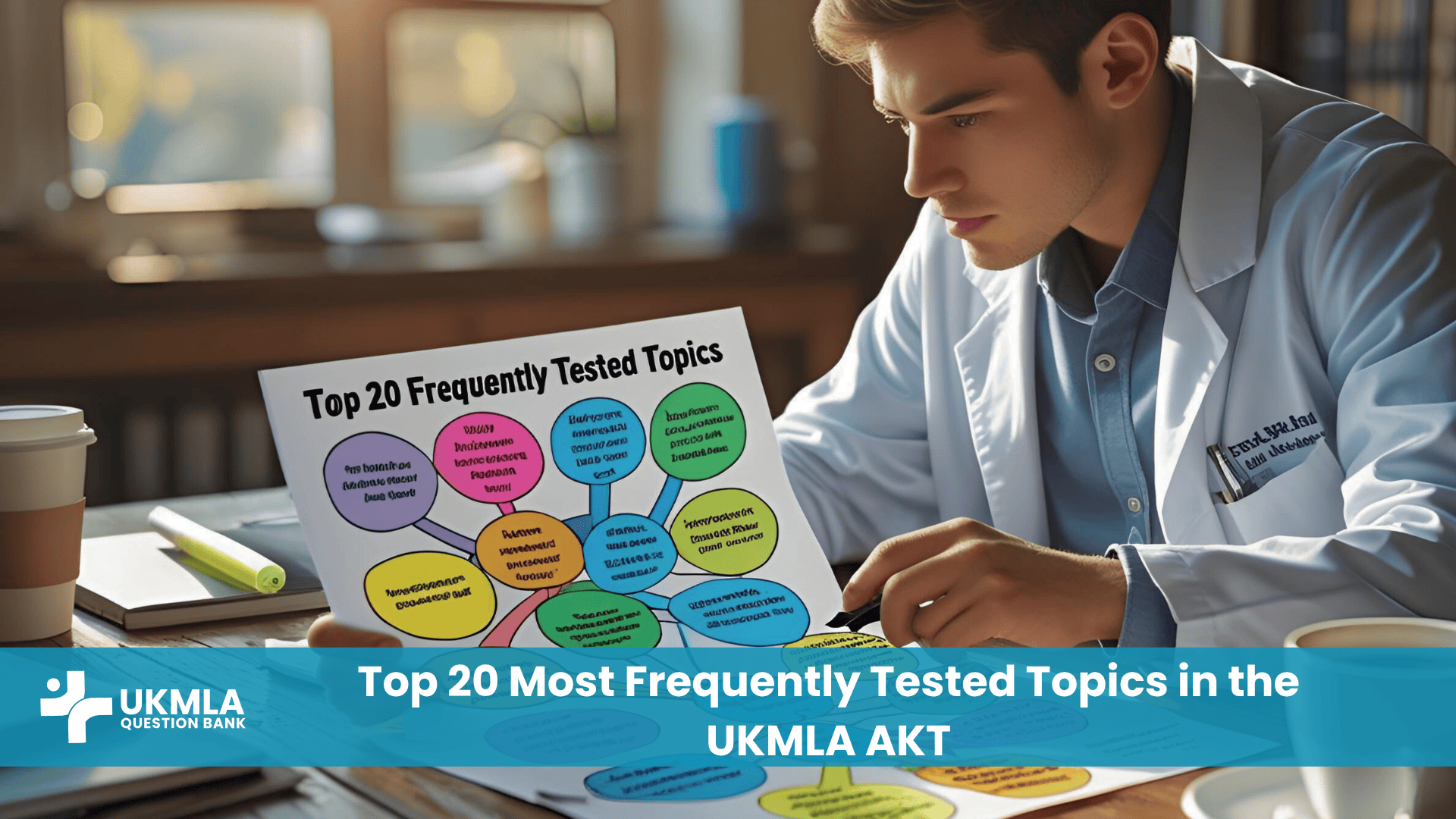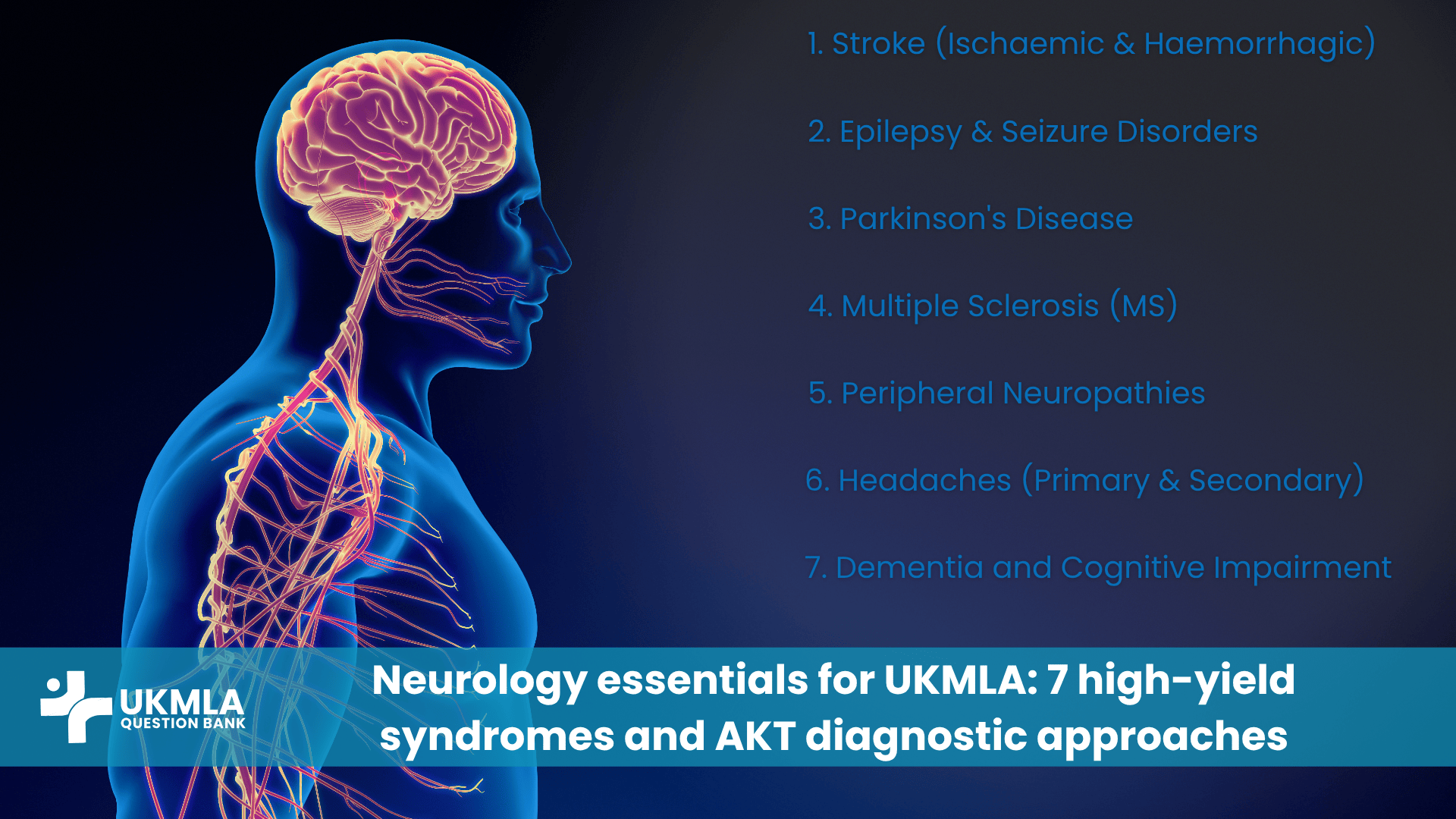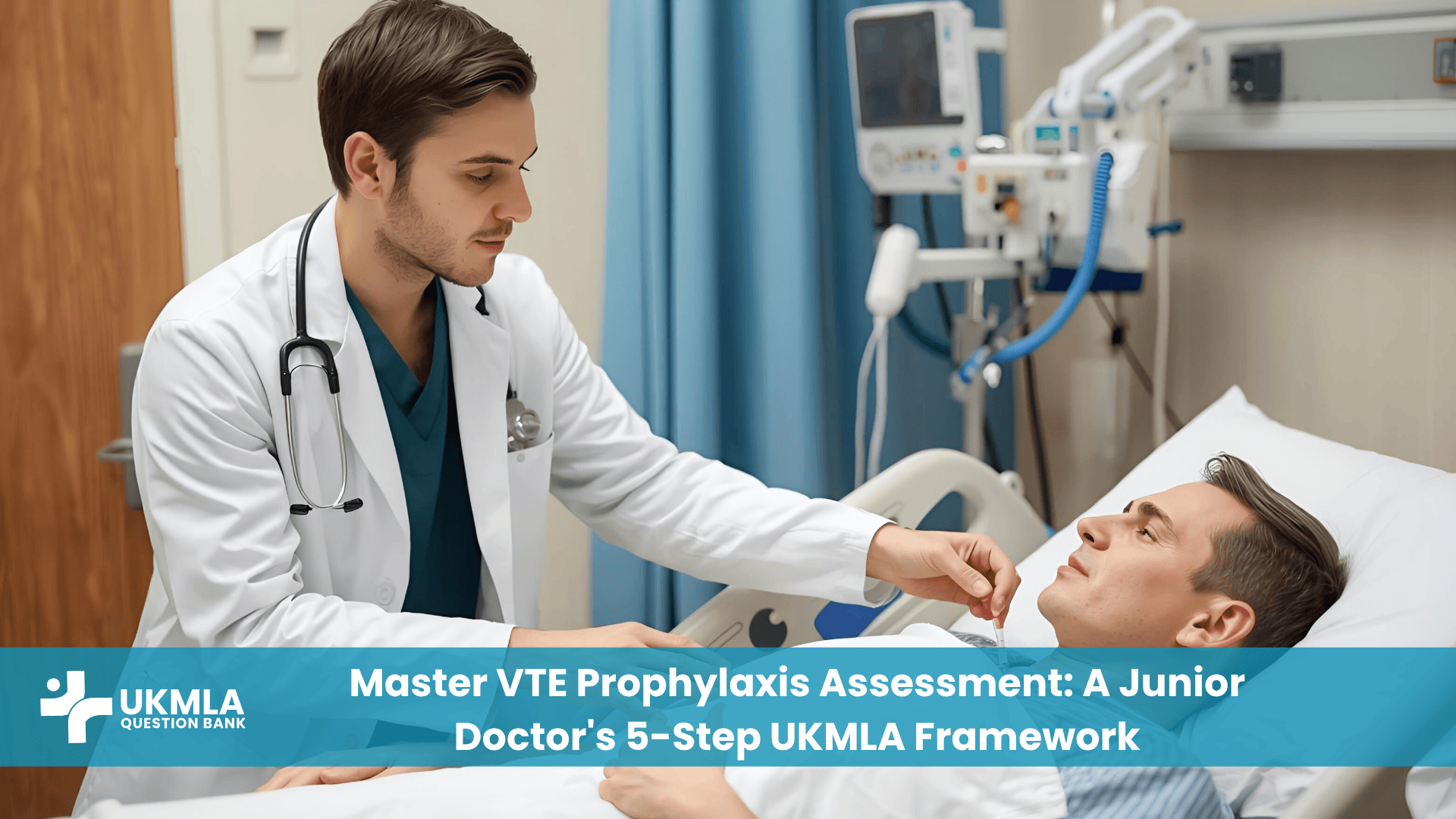For any medical professional preparing for the exam, understanding the frequently tested topics in the UKMLA AKT is the most critical step toward an effective revision strategy. Staring at the vast expanse of clinical medicine, it’s easy to wonder where to even begin. A common anxiety is spending precious time on obscure conditions while missing the core material that will almost certainly appear on exam day.
This guide is your strategic advantage. We are not just creating a list; we are providing a focused roadmap based on the principles outlined in the GMC’s content map, which prioritizes common presentations, acute emergencies, and conditions that a Foundation Year doctor must manage safely. We will count down the top 20 most consistently examined areas, giving you a clear framework to structure your learning and build your confidence for exam day.
Key Takeaways
- The 80/20 Principle: A focused effort on these 20 high-yield topics will likely cover a disproportionately large percentage of the questions you will face on the UKMLA AKT.
- Common is Common: The UKMLA tests your readiness for safe practice. It focuses heavily on common conditions (like hypertension, asthma, diabetes) and acute emergencies (like ACS, sepsis, GI bleeds).
- Guidelines are Gospel: For every topic listed, your knowledge must be anchored in current UK guidelines, primarily from NICE and other key bodies like the Resuscitation Council UK.
- Integrate Your Knowledge: Don’t study these topics in isolation. Understand the underlying pathophysiology, clinical features, key investigations, and the pharmacological principles of management for each.
- Use as a Guide, Not a Crutch: This list is a powerful tool to direct your study but does not replace the need for a comprehensive understanding of medicine as outlined in The GMC UKMLA Content Map: Your Blueprint for Success.
Core Medicine: The Most Frequently Tested Topics in the UKMLA AKT
We’ve grouped the top 20 topics into key clinical areas to help structure your revision. For each topic, we’ll highlight why it’s so frequently tested and what you need to know.
Cardiovascular Medicine
Cardiology is arguably the highest-yield specialty in any medical licensing exam.
1. Acute Coronary Syndromes (ACS)
- Why it’s high-yield: A leading cause of death and a common emergency admission. You must be able to interpret an ECG, differentiate between STEMI, NSTEMI, and unstable angina, and know the immediate management (MONA-B: Morphine, Oxygen, Nitrates, Aspirin + Beta-blocker/Clopidogrel).
2. Atrial Fibrillation (AF)
- Why it’s high-yield: The most common sustained cardiac arrhythmia. Key concepts include rate vs. rhythm control strategies and, crucially, assessing stroke risk (CHA₂DS₂-VASc) and bleeding risk (ORBIT/HAS-BLED) to guide anticoagulation.
3. Heart Failure
- Why it’s high-yield: A prevalent long-term condition with acute exacerbations. You need to know the causes, clinical signs (e.g., raised JVP, bibasal crackles, peripheral oedema), key investigations (BNP, echocardiogram), and the principles of management (ACE inhibitors, beta-blockers, diuretics).
4. Hypertension
- Why it’s high-yield: A massively common condition and a major risk factor for stroke, IHD, and CKD. The NICE management ladder, including when to step up and which drugs to use based on age and ethnicity, is a classic exam topic. You can find more detail in our Cardiology Essentials for UKMLA guide.
Respiratory Medicine
Respiratory emergencies and chronic diseases are central to the life of a junior doctor.
5. Asthma
- Why it’s high-yield: A common chronic disease with a life-threatening acute presentation. You must know the step-wise management of chronic asthma and, critically, how to recognise and manage an acute, severe exacerbation.
6. Chronic Obstructive Pulmonary Disease (COPD)
- Why it’s high-yield: Another common chronic condition with frequent infective exacerbations. Differentiating it from asthma is key. Understanding the role of inhalers, home oxygen criteria, and management of an acute flare (controlled oxygen, steroids, antibiotics, nebulisers) is vital.
Key Point: Differentiating between Asthma and COPD is a classic exam challenge. Key features like diurnal variability (asthma) and a significant smoking history with progressive, non-reversible airflow obstruction (COPD) are crucial clues.
Table 1: Differentiating Features of Asthma vs. COPD
| Feature | Asthma | COPD |
|---|---|---|
| Age of Onset | Typically < 35 years | Typically > 35 years |
| Smoking History | Not necessarily causal | Almost always present |
| Symptom Pattern | Diurnal variability, worse at night/early morning, triggered | Persistent, progressive, daily symptoms |
| Sputum | Often absent or mucoid | Chronic, productive cough is common |
| Breathlessness | Episodic | Progressive and persistent |
| Atopy | Strong association (eczema, hay fever) | Not a typical feature |
| Reversibility | Significant response to bronchodilators | Minimal or no significant reversibility |
7. Pneumonia
- Why it’s high-yield: A very common infection leading to hospital admission. Key knowledge includes typical vs. atypical organisms, using the CURB-65 score to assess severity and guide admission decisions, and antibiotic choices.
8. Pulmonary Embolism (PE)
- Why it’s high-yield: A common and potentially fatal condition that often presents with non-specific symptoms. You must know the risk factors (e.g., recent surgery, immobility, malignancy), the Wells score for risk stratification, and the diagnostic pathway (D-dimer for low-risk, CTPA for high-risk).
Endocrinology, Gastroenterology & Renal
This group covers metabolic chaos and core gut and kidney issues.
9. Diabetes Mellitus (Types 1 & 2)
- Why it’s high-yield: A global epidemic with numerous complications. You must understand the diagnostic criteria, differences between T1DM and T2DM, and management principles. Crucially, you must know how to recognise and manage the acute emergencies: Diabetic Ketoacidosis (DKA) and Hyperosmolar Hyperglycaemic State (HHS).
10. Thyroid Disorders
- Why it’s high-yield: Hypothyroidism and hyperthyroidism (especially Graves’ disease) are very common. Interpreting thyroid function tests (TSH, T3, T4) and knowing the classic signs and symptoms is essential.
11. Inflammatory Bowel Disease (IBD)
- Why it’s high-yield: A classic topic focusing on the differentiation between Crohn’s and Ulcerative Colitis. See our in-depth Gastroenterology and Hepatology Essentials for UKMLA for a detailed breakdown.
12. Upper GI Bleed
- Why it’s high-yield: An acute medical emergency requiring a systematic ABCDE approach. Key knowledge includes causes (peptic ulcers, varices), risk scoring (Blatchford/Rockall), and initial management steps.
13. Chronic Liver Disease & Cirrhosis
- Why it’s high-yield: The causes (alcohol, NAFLD, viral hepatitis) and, more importantly, the signs of decompensation (jaundice, ascites, encephalopathy) are frequently tested.
14. Acute Kidney Injury (AKI)
- Why it’s high-yield: Extremely common in hospital inpatients. You need to know how to classify AKI based on creatinine/urine output, differentiate between pre-renal, renal, and post-renal causes, and the principles of management (fluid balance, treating the cause, stopping nephrotoxic drugs).
Neurology & Psychiatry
Neurological cases form a key component of the frequently tested topics in the UKMLA AKT.
15. Stroke & TIA
- Why it’s high-yield: A major cause of disability and a time-critical emergency. You must be able to differentiate ischaemic vs. haemorrhagic stroke, understand the role of the ROSIER score, and know the immediate management pathways (thrombolysis/thrombectomy for ischaemic stroke).
16. Seizures & Epilepsy
- Why it’s high-yield: A common neurological presentation. Key areas include differentiating seizure types (focal vs. generalised), the immediate management of a prolonged seizure (status epilepticus) with benzodiazepines, and the basic principles of anti-epileptic drugs.
17. Meningitis & Encephalitis
- Why it’s high-yield: A life-threatening infection. Recognising the key signs (fever, headache, neck stiffness, photophobia, non-blanching rash) and starting immediate antibiotics and supportive care (even before definitive diagnosis with a lumbar puncture) is a critical safety issue.
18. Depression & Anxiety
- Why it’s high-yield: Extremely common in primary care and hospital settings. You should know the core diagnostic features, how to perform a risk assessment, and the principles of management, including psychological therapies and first-line SSRI antidepressants.
General Principles and Acute Care
These are overarching themes that apply across all specialties.
19. Sepsis
- Why it’s high-yield: Sepsis is a final common pathway for many infections and a leading cause of death in hospitals. Recognising it early (using tools like NEWS2) and acting fast is paramount.
A Note from an Acute Medicine Consultant: “If you learn one emergency management pathway inside and out, make it sepsis. The patient who looks a ‘bit unwell’ with a high respiratory rate could be minutes away from cardiovascular collapse. Never delay giving the Sepsis Six bundle once you suspect it. It saves lives, and it will definitely save you points on the exam.”
Table 2: The Sepsis Six Pathway
| The “Take Three” (Investigations & Monitoring) | The “Give Three” (Interventions) |
|---|---|
| 1. Take Blood Cultures: Before giving antibiotics. | 1. Give High-Flow Oxygen: To maintain sats 94-98%. |
| 2. Take Lactate: A key marker of tissue hypoperfusion. | 2. Give IV Broad-Spectrum Antibiotics: As per local guidelines. |
| 3. Monitor Urine Output: Catheterise to accurately measure. | 3. Give IV Fluid Resuscitation: A bolus of crystalloid. |
20. Common Drug Side Effects
- Why it’s high-yield: This is a vast but essential area. The UKMLA will frequently present a patient with symptoms that are actually a side effect of their medication. You must know the classic side effects of common drug classes (e.g., ACE inhibitors causing a dry cough, NSAIDs causing peptic ulcers and AKI, statins causing myopathy).
Key Point: Always take a thorough drug history. If a patient presents with new symptoms, ask yourself: “Could this be caused by one of their medications?” This simple question is a vital diagnostic step.
Frequently Asked Questions (FAQ) Your UKMLA AKT Topics Questions Answered
No. This list represents the most high-yield and frequently tested topics, but it is not exhaustive. You are still expected to have a broad knowledge of medicine as outlined in the GMC UKMLA content map.
This list was curated based on an analysis of the GMC UKMLA content map’s emphasis on common and acute conditions, historical data from UK medical finals, and the core competencies expected of a Foundation Year 1 doctor.
Absolutely not. You should use this list to prioritise your revision and ensure your foundational knowledge is strong in these key areas, but you must still cover the breadth of the curriculum.
Use a combination of a core textbook or online resource to understand the topic, then solidify your knowledge by doing practice questions from a high-quality UKMLA question bank.
While it’s impossible to give an exact percentage, these topics consistently form the backbone of medical licensing exams. A strong performance in these areas is crucial for passing.
While paediatrics and O&G are part of the UKMLA syllabus, this list focuses on the most frequently tested general medical and surgical topics that are universally managed by Foundation doctors. Speciality-specific topics form another important, but distinct, area of revision.
The primary source for UK guidelines is the National Institute for Health and Care Excellence (NICE). Their website provides concise “Clinical Knowledge Summaries” (CKS) for most conditions.
Yes. While the format is different, the clinical knowledge required is the same. Many of these conditions (e.g., Asthma, Sepsis, Heart Failure) are classic scenarios for CPSA stations.
You should use a system of spaced repetition. After studying a topic, revisit it with practice questions a few days later, then a week later, and so on, to ensure the information moves into your long-term memory.
Professionalism, ethics, and law are crucial “domain-level” topics that are woven into many clinical scenarios. While not a “topic” like pneumonia, a question about pneumonia could easily have an ethical or legal component.
Conclusion: Focusing on These Frequently Tested Topics in the UKMLA AKT
The journey to UKMLA success can feel like a marathon, but it doesn’t have to be a directionless one. By focusing your revision on these top 20 frequently tested topics in the UKMLA AKT, you can study smarter, not just harder. These areas represent the core of what it means to be a safe and competent junior doctor in the UK.
Use this list to guide your reading, direct your question bank practice, and build a solid foundation of knowledge. A deep understanding of these conditions will empower you to handle a huge proportion of the AKT with confidence. For more on how to apply this knowledge, read our guide on Mastering the UKMLA AKT: Proven Strategies for a High Score.
Call to Action:
Now that you know where to focus your efforts, the next step is to put that knowledge to the test. Dive into targeted practice questions with a UKMLA Question Bank: An Essential Resource for Medical Aspirants to solidify your understanding of these high-yield topics.




